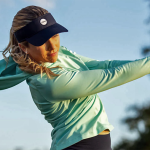In sharp contrast to their male counterparts, sports apparel is purchased more often by women than either footwear or equipment and the younger the female consumer, the more frequently she will purchase sports apparel. Women with children are also more likely to purchase sports apparel more often than women without children, which presents an opportunity for the sporting goods market to address the needs of the female consumer as she shops for and with her family. Those insights were gleaned from the just released What Women Want study produced by The SportsOneSource Group.
“There is clear evidence that women present a terrific opportunity for sporting goods stores and athletic specialty retailers that rely on kids and teen sales,” said James Hartford, chief market analyst for The SportsOneSource Group. “There is a correlation between frequency of visits to stores for childrens purchases and the purchase of apparel.”
The What Women Want study, which polled 3,680 women about sporting goods and athletic footwear and apparel, shopping habits and brand preferences, shows that women of all ages with children at home under the age of 18 are far more likely to purchase sports apparel more frequently than women without children, a clear indication she is making the familys purchase decisions.
While 54.5% of women with children under the age of 18 living at home purchased sports apparel at least one every six months, only 44.9% of the women without children did so. Women with children were 50% more likely to purchase sports apparel once a month compared to the women without children.
While women with children were also more likely to purchase athletic footwear and sporting goods equipment more frequently than women without children, they do indicate a higher frequency of apparel purchases than either footwear or equipment. Women were more than twice as likely to purchase sports apparel once a month versus athletic footwear or sporting goods equipment. Over 52% of the women respondents over the age of 18 said they purchased apparel at least once every six months, while 47% indicated that frequency level for footwear.
On the down side, women spent less than their male counterparts on apparel and equipment over the last year. While adult female respondents to the survey indicated they spent $244 on average on athletic footwear over the last year, compared to $248 for adult males, the gap widened quite a bit with apparel and equipment. Adult male respondents indicated they spent $303 on average on sports apparel, while adult women reported spending $275 on average. In sports equipment, adult male respondents said they spent $437 over the last year, while adult women said they spent $371 on equipment.
The average amount spent on sport apparel in the last year peaked with women respondents in the 35- to 44-year-old age group, while the amount spent on athletic footwear and sports equipment peaked with the 45- to 54- year-old female consumer. The differential in the apparel purchases was low enough that the study could conclude that overall purchases would peak in the 45- to 54- year-old group. The age group was the key age range for both the women with children and without children. Interestingly, the women in the 45- to 54- year-old group without children spent far more – especially in equipment – that the women without children in the 35- to 44-year-old group, while the differential between the two age groups for the women without children at home under the age of 18 was far less.
When deciding where to shop to purchase athletic product women tend to turn to full-line sporting goods and discount/mass merchants when purchasing equipment. For both the sporting goods and discount/mass channels, 43% of women respondents reported making equipment purchases in the channel.
Given the footwear-heavy assortments seen at mall athletic specialty stores, it comes as no surprise that more women respondents reported making footwear purchases in the channel than in any other. Just over 40% of women respondents reported purchasing footwear at a mall specialty retailer. Full-line sporting good retailers (37%) was the second channel mentioned most often for athletic footwear, followed closely by department stores, with 36% of women respondents purchasing footwear in the channel. But when purchasing apparel, women respondents went to discount/mass merchants. Nearly 60% of all the women respondents who have purchased apparel over the past year did so at a discount/mass retailer.
Department stores were mentioned next as the retail location women respondents most frequently chose when making an apparel purchase. Nearly half of the women respondents mentioned purchasing apparel at a Department Store.
“This feedback is consistent with other reports conducted by The SportsOneSource,” added Hartford. “This is also consistent with our observations that mothers are more likely to allow children to buy branded sneakers in the mall or sporting goods stores, but are more likely to force an apparel purchase at a Kohls or Walmart.”
There is evidence that quality and durability are more important than ever, given the recession. In a recent response to an SGB Question , Kalinda Bogue, director of marketing at Rollerblade, said that in the recession, women will filter purchases with a very tight focus on how it improves the quality of her familys life. The data compiled in the What Women Want study supports this notion. Product quality was the top attribute given for why women make sports-related purchases. Women with children were likely to put more emphasis on the price/value relationship than the female respondents without children, but product was roughly equal to value as the top attribute in purchase decisions.















